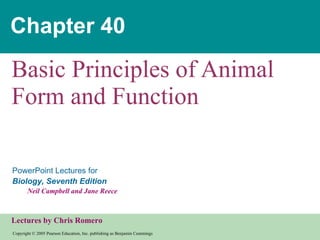40 animalform&function text
•Transferir como PPT, PDF•
1 gostou•1,690 visualizações
Denunciar
Compartilhar
Denunciar
Compartilhar

Mais conteúdo relacionado
Mais procurados
Mais procurados (20)
Writing introduction, hypothesis and objectives of a thesis and scientific pa...

Writing introduction, hypothesis and objectives of a thesis and scientific pa...
Biology cell theory-and-and spontaneuous generation

Biology cell theory-and-and spontaneuous generation
Biology - Chp 1 - Biology The Study Of Life - PowerPoint

Biology - Chp 1 - Biology The Study Of Life - PowerPoint
Semelhante a 40 animalform&function text
Semelhante a 40 animalform&function text (20)
1. animal form and function. animal form and function. animal form and function

1. animal form and function. animal form and function. animal form and function
What is life biology, science, and how we study things.

What is life biology, science, and how we study things.
Mais de Andrew McCaskill
Mais de Andrew McCaskill (20)
40 animalform&function text
- 1. Chapter 40 Basic Principles of Animal Form and Function
- 12. External environment Food CO 2 O 2 Mouth Animal body Respiratory system Circulatory system Nutrients Excretory system Digestive system Heart Blood Cells Interstitial fluid Anus Unabsorbed matter (feces) Metabolic waste products (urine) The lining of the small intestine, a diges- tive organ, is elaborated with fingerlike projections that expand the surface area for nutrient absorption (cross-section, SEM). A microscopic view of the lung reveals that it is much more spongelike than balloonlike. This construction provides an expansive wet surface for gas exchange with the environment (SEM). Inside a kidney is a mass of microscopic tubules that exhange chemicals with blood flowing through a web of tiny vessels called capillaries (SEM). 0.5 cm 10 µm 50 µm Figure 40.4